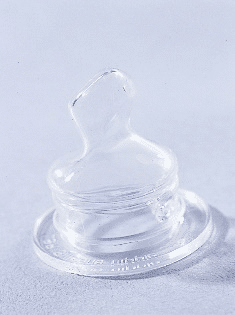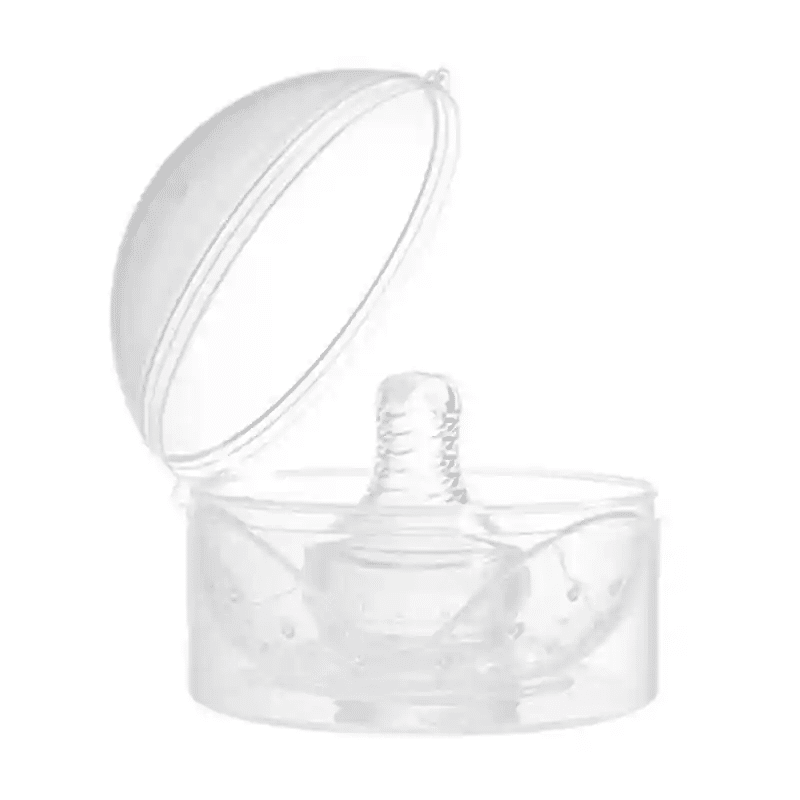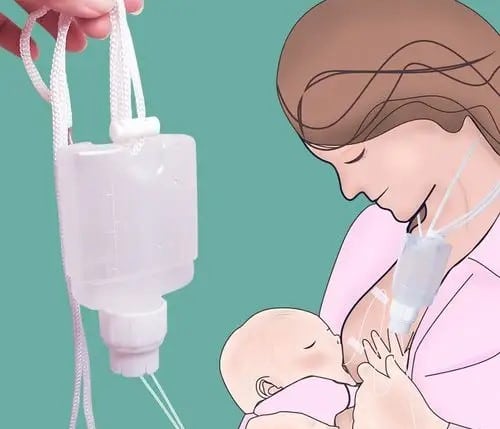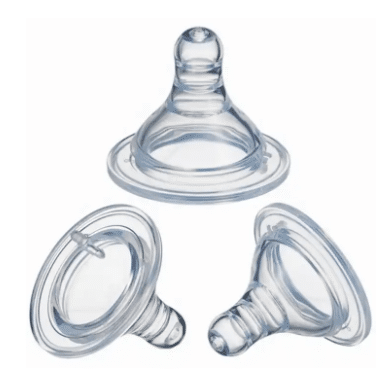How to use silicone products to solve the problem of baby nipple confusion
Nipple confusion refers to the phenomenon that the newborn sucks the bottle before sucking the mother’s nipple, or frequently uses the bottle to feed the baby for various reasons, resulting in the baby not sucking or unwilling to suck breast milk. Nipple confusion has become an important cause of breastfeeding failure.
Why does baby nipple confusion occur
When breastfeeding, the baby can suck breast milk by squeezing the areola with the tongue and jaw. However, bottle feeding works slightly differently: due to gravity and the design of the pacifier, when sucking on a bottle, as long as the mouth draws lightly, the milk in the bottle is drained due to the negative pressure in the mouth.
After the baby gets used to the bottle sucking way, there is technical confusion when sucking breast milk, and over time, it is unwilling to suck the mother’s nipple, leading to breastfeeding failure and a sharp decline in milk volume. In addition, if the shape of the pacifier nipple is also different from the bottle or breast, some babies may have difficulty effectively choosing between the three.
What are the applications of silicone products in solving nipple confusion
Nipple protector: Designed to simulate the appearance and touch of the nipple and made of medical silicone, it can provide the mother with nipple protection while breastfeeding, but also help the baby adapt to the correct position, and guide the baby from the pacifier sucking to breastfeeding.
Auxiliary nursing device: A lactation aid consists of a container, usually a feeding bottle with an enlarged pacifier opening, and a slender tube protruding from the container. The baby should hold the breast first, and the tube can be slipped into the baby’s mouth when the baby just starts to show signs of impatient sucking. The more correct the baby’s position, the easier it is to eat your breast milk, and the easier it is to use the auxiliary device. The experience of mother and baby snuggling up to each other and working together is absolutely beneficial for increasing the closeness and trust between mother and child, and nurturing the mother and child emotion.
When do I need to use silicone products to resolve nipple confusion
When there is nipple confusion, the baby’s common manifestations are to see the nipple crying, sucking ability is weak, and refusing the nipple.
See the nipple crying: if the baby often uses a pacifier to breastfeed, has adapted to the pacifier feeding, and when the nipple is fed again, there may be nipple confusion, crying, shaking and other phenomena such as seeing or touching the nipple.w
Weak sucking power: the material and taste of the nipple is different from that of the bottle, and after the nipple is confused with the baby who has been adapted to the pacifier feeding, the mother can obviously feel that the child’s sucking power is weak, and the long-term sucking is still not enough to eat.
Refusal of nipples: Infants with serious nipple confusion may even refuse breast milk. Even if the nipple is placed in the baby’s mouth, the baby will push it out with the tongue, or refuse to hold the nipple in the mouth when breastfeeding.
Jution Silicone & Rubber Co., LTD: Pioneering Custom silicone nipple protector for Over 16 Years. As a professional manufacturer in designing and manufacturing high-quality LSR/SSR baby products in China for over 16 years’ experience.
Our team is experienced in working with baby products brands/wholesale/retails/corporate gifts company offer the custom silicone nipple protector from sketch to contract Manufacturing meet the unique needs of each silicone nipple protector project.
How to choose the right silicone products
Material safety: The preferred food grade silicone material, this material can withstand high temperature disinfection, ultraviolet disinfection, etc., to ensure that the baby’s entrance is safer .
Brand reputation: Choose well-known brands of products, these brands of silicone products are usually more guaranteed quality, will not contain harmful substances .
Reasonable design: the size and shape of the nipple protection cover should fit with the mother’s nipple, and have good flexibility and elasticity; The catheter size of the auxiliary feeder is moderate, which is easy for the baby to suck.
How to use silicone products to solve nipple confusion
Preparation: Thoroughly clean and disinfect the silicone products before use, and let the mother relax herself and let the baby be in a warm and comfortable environment.
Procedure for using nipple protector: Turn the inside of the protective cover half out and apply a small amount of breast milk or water to the inside. Align the shield with the nipple so that the nipple is placed over the nipple of the shield. Fold the outer layer back and gently press around to make the shield fit tightly to the areola. When feeding the baby, you can gently hold the protective cover to prevent it from falling off.
Procedure for using auxiliary nursing device: Fill the feeder with breast milk or formula, connect the silicone catheter, and place the catheter head next to the nipple so that the baby can hold the catheter head and nipple at the same time. Adjust the milk flow rate as your baby sucks.
Conclusion
When mothers are faced with the maddening problem of nipple confusion, they can use the right silicone products to help their baby get through this period smoothly. Usually, mothers should also closely observe the reaction and situation of the baby when using, and regularly replace the aging silicone products to ensure that they can eventually achieve full pro-feeding under safe circumstances.
Jution silicone’s services working steps include silicone protector initial concept development, silicone protector 3D design and engineering, prototype and mold development, silicone protector contract mass production with silicone molding, silicone protector Logo branded, silicone protector QC and Package and fulfillment. So, in Jution silicone, you can custom silicone protector function, material, structure, shape, sizes, color, logo and package.
Related Blog
-

ilicone Training Cup, Anti-Leakage And Anti-Choking Measures!Your Baby Deserves To Have This!
Silicone training cup, Anti-leakage and anti-choking measures!Your baby deserves to have this! Over the years, I have witnessed how silicone materials have reshaped the landscape of maternal and infant products with their unparalleled safety and functionality. The transition of babies from bottles to cups is an important part of their growth process. At this time,
-

The best silicone bottle for your baby
The best silicone bottle for your baby This article mainly discusses the differences between silicone baby bottles and other baby bottles, the usage scenarios, usage time and cleaning solutions of silicone baby bottles. If you are interested in the above content, please read in depth to get more information. What is a silicone baby bottle?
-

How to choose silicone pacifier orthodontics
How to choose silicone pacifier orthodontics A pacifier is a baby product, usually made of silicone or rubber, that helps soothe a baby’s emotions and pain. They are designed to resemble nipples and allow babies to suck on them to comfort themselves. Using a pacifier can help the baby calm down and fall asleep, reduce
-

Pacifiers: Natural Rubber Latex vs Silicone
Pacifiers: Natural Rubber Latex vs Silicone A pacifier is a silicone product similar to a mother’s nipple, which is mainly used to calm the baby’s emotions. It can provide sucking while your baby is crying or sleeping to help calm your baby and satisfy its non-nutritive sucking needs. It not only soothes your baby’s mood,
-

How to use silicone products to solve the problem of baby nipple confusion
How to use silicone products to solve the problem of baby nipple confusion Nipple confusion refers to the phenomenon that the newborn sucks the bottle before sucking the mother’s nipple, or frequently uses the bottle to feed the baby for various reasons, resulting in the baby not sucking or unwilling to suck breast milk. Nipple





